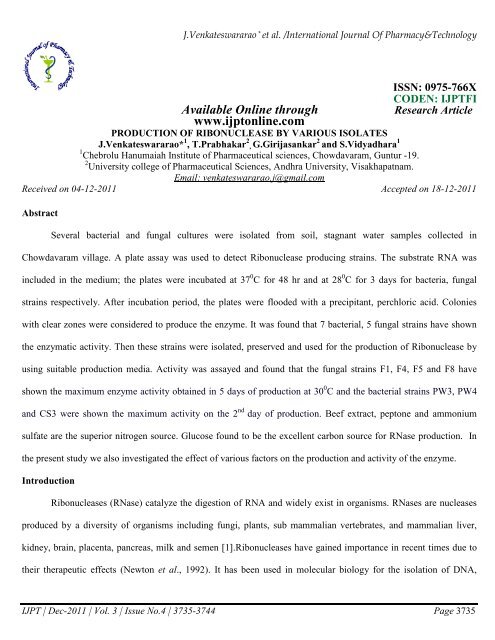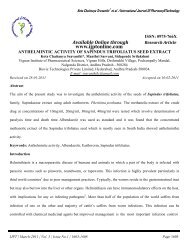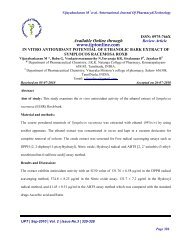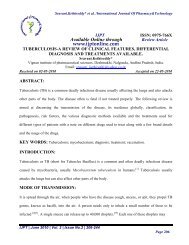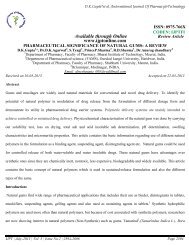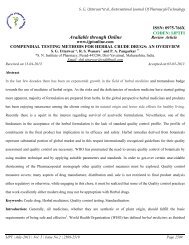Available Online through www.ijptonline.com
Available Online through www.ijptonline.com
Available Online through www.ijptonline.com
Create successful ePaper yourself
Turn your PDF publications into a flip-book with our unique Google optimized e-Paper software.
J.Venkateswararao * et al. /International Journal Of Pharmacy&TechnologyISSN: 0975-766XCODEN: IJPTFI<strong>Available</strong> <strong>Online</strong> <strong>through</strong>Research Article<strong>www</strong>.<strong>ijptonline</strong>.<strong>com</strong>PRODUCTION OF RIBONUCLEASE BY VARIOUS ISOLATESJ.Venkateswararao* 1 , T.Prabhakar 2 , G.Girijasankar 2 and S.Vidyadhara 11 Chebrolu Hanumaiah Institute of Pharmaceutical sciences, Chowdavaram, Guntur -19.2 University college of Pharmaceutical Sciences, Andhra University, Visakhapatnam.Email: venkateswararao.j@gmail.<strong>com</strong>Received on 04-12-2011 Accepted on 18-12-2011AbstractSeveral bacterial and fungal cultures were isolated from soil, stagnant water samples collected inChowdavaram village. A plate assay was used to detect Ribonuclease producing strains. The substrate RNA wasincluded in the medium; the plates were incubated at 37 0 C for 48 hr and at 28 0 C for 3 days for bacteria, fungalstrains respectively. After incubation period, the plates were flooded with a precipitant, perchloric acid. Colonieswith clear zones were considered to produce the enzyme. It was found that 7 bacterial, 5 fungal strains have shownthe enzymatic activity. Then these strains were isolated, preserved and used for the production of Ribonuclease byusing suitable production media. Activity was assayed and found that the fungal strains F1, F4, F5 and F8 haveshown the maximum enzyme activity obtained in 5 days of production at 30 0 C and the bacterial strains PW3, PW4and CS3 were shown the maximum activity on the 2 nd day of production. Beef extract, peptone and ammoniumsulfate are the superior nitrogen source. Glucose found to be the excellent carbon source for RNase production. Inthe present study we also investigated the effect of various factors on the production and activity of the enzyme.IntroductionRibonucleases (RNase) catalyze the digestion of RNA and widely exist in organisms. RNases are nucleasesproduced by a diversity of organisms including fungi, plants, sub mammalian vertebrates, and mammalian liver,kidney, brain, placenta, pancreas, milk and semen [1].Ribonucleases have gained importance in recent times due totheir therapeutic effects (Newton et al., 1992). It has been used in molecular biology for the isolation of DNA,IJPT | Dec-2011 | Vol. 3 | Issue No.4 | 3735-3744 Page 3735
J.Venkateswararao * et al. /International Journal Of Pharmacy&TechnologyRNase protection assays and for mapping single base mutations in RNA. Ribonucleases may exhibit activities otherthan ribonucleolytic activity, such as anti mitogenic [2], antibacterial, antifungal [3], antiproliferative, antiviralactivity [1,4], HIV-I reverse transcriptase inhibitory[5], translation inhibitory[6] and angiogenic[7] activities. As thedemand for DNA vaccines and biological drugs increases, usage of ribonuclease attached to a solid support(immobilized) is better way which has many advantages over free enzymes [8]. RNase has extensive applications asan analytical enzyme, for the determination of structure, nearest neighbour sequence and sequence of RNA(Sambrook and Russell, 2001). In single cell protein production they are used to remove RNA from cell [9]. Theseenzymes are produced by numerous microorganisms among which the fungi are the most potent producers. RNasehas also been used for the synthesis of oligonucleotides and in the manufacture of nucleotides 2’, 5'-cyclicphosphates (Rowe and Smith, 1972; Chacko and Shankar, 1998). Many RNases are highly cytotoxic. Recently, aseries of scientific studies showed that RNases had important biological functions, in controlling the tumorformation [10].In recent years, the RNase functions related to the control of gene expression, cell growth and differentiation, cellprotection from pathogens, and apoptosis induction have received special attention [11]. In view of the numerousapplications of RNase, the work presented, addresses the exploitation of microorganisms for extracellular RNaseproducing microorganisms.Materials and MethodsCommercial yeast RNA was purchased from Sisco Research Laboratories, Mumbai, India. Ribonuclease-AType (I-A) procured from Sigma Chemical Co, St. Louis, MO, USA. Uranyl acetate was a product of Loba Chemie,Mumbai, India. Pre-sterile disposable Petri plates, potato dextrose agar [PDA] and nutrient agar [NA] werepurchased from Hi Media Laboratories Pvt. Ltd, Mumbai, India, and all other chemicals used were of analyticalgrade. Several bacterial and fungal cultures were isolated from soil, stagnant water samples collected inChowdavaram village. The fungal strains were routinely maintained on potato dextrose agar slants and bacterialstrains on nutrient agar slants.IJPT | Dec-2011 | Vol. 3 | Issue No.4 | 3735-3744 Page 3736
Preparation of media for screeningJ.Venkateswararao * et al. /International Journal Of Pharmacy&TechnologyMedia was modified for use, as shown in the following schematic representation.Potato dextrose agar / Nutrient agar(dissolved in 250 ml distilled water)↓Sterilization (121 0 C, 15 lb pressure, for 15 min.)↓cool to 50 0 CAdded RNA (1.5 g) dissolved in 0.1 M PO 4 buffer (pH 8)↓Gently rotated to ensure uniform mixing↓Pour 20 ml in each Petri dish↓After solidification used for screeningFig.1 preparation of screening medium for RNase.Screening for Ribonuclease:Different cultures (fungi, bacteria) were prepared as suspensions and screened for extracellular RNase, byinoculating into the cups made in respective plates containing modified agar medium as indicated above. The plateswere then incubated at required temperatures until growth was clearly visible. After incubation the plates wereflooded with 3 ml of the precipitant (perchloric acid) and left to stand for 5 min. The plates were then visualized fortransparent halos formed around the grown colonies, against an opalescent RNA background. These cultures, whichproduced clear zones were preserved and used for the fermentation.Production by fermentationIJPT | Dec-2011 | Vol. 3 | Issue No.4 | 3735-3744 Page 3737
J.Venkateswararao * et al. /International Journal Of Pharmacy&TechnologyThe fermentation process was carried out for the isolated bacterial, fungal cultures separately in 500mlErlenmeyer flasks with 100ml working volume. For each bacterial culture inoculum was developed the mediumcontaining glucose(1.5%), yeast extract (0.5%), beef extract (0.5%), peptone (1.0%), MgSO 4 .2H 2 O (0.05%),CaCl 2 .2H 2 O (0.01%) and traces of RNA, p H was adjusted to 7.0 and incubated at 37 0 C on a rotary shaking incubatorat 150 rpm for 48hr. Fungal isolates were grown in the medium contains 100ml sterile medium glucose (3.0%), beefextract (0.5%), peptone (1.0%), MgSO 4 .2H 2 O (0.05%), CaCl 2 .2H 2 O (0.01%). Seed cultures were prepared byincubating the flasks with spores suspension (1ml, about 10 7 spores) was inoculated into each flask for 24hr at theirrespective temperatures. The fermentation medium, which is similar to the inoculum, inoculated with 10% (v/v) seedculture. The flasks were placed on a rotary shaker at 180 rpm 30°C for 120hr., to produce RNase by fungal strains.Similarly, bacterial strains at 150 rpm 37 0 C for 48hr. After fermentation, the biomass was separated from the culturefluids by filtration and then the filtrates were used to determine the enzyme activity. The growth of bacteria andfungus were measured and expressed as their cell dry weight.Determination of Ribonuclease ActivityRibonuclease activity was assayed by modified Kalnitsky et al. method. The rate of hydrolysis of yeast RNAis determined by measuring the amount of acid soluble oligonucleotide released under defined conditions.0.5 ml of suitably diluted enzyme solution was placed in 10 ml centrifuge tubes, Included a blank containing 1ml of0.15 M tris buffer, pH 8.2 containing 0.25mM EDTA, added 1ml of 1% RNA , incubated all tubes at 37°C for 8-10minutes and stopped the reaction by the addition of 1 ml of Uranyl acetate-Perchloric acid solution. Transferred toan ice-bath and cool for 5minutes. Clarified by centrifugation at 10000 rpm for 10 min., and diluted 0.5 ml of clearsupernatant to 3.5 ml with reagent grade water. Read A 260 versus blank. All values are corrected for a zero timeblank approx. 0.4 unit/ml. The amount of acid-soluble ribonucleotides was calculated by assuming a molarabsorption coefficient of 10,600 L.mol -1 cm -1 (4).One unit causes an increase in absorbance of 1.0 at A 260 at 37°C under the specified conditions.Results and DiscussionIJPT | Dec-2011 | Vol. 3 | Issue No.4 | 3735-3744 Page 3738
J.Venkateswararao * et al. /International Journal Of Pharmacy&Technology33 bacterial, 08 fungal strains were isolated from the soil, stagnant water samples collected in and aroundchowdavaram. Out of these 6 bacterial, 5 fungal strains have shown the ability to produce Ribonuclease, especiallythe bacterial strains PW3, PW4 and CS3 and the fungal strains F1, F4, F5 and F8 were shown good enzymaticactivity.PW3 and F5 were selected for further study, because of their high enzymatic activity when <strong>com</strong>pared withothers. Fermentation process was carried out for the above cultures separately in 500ml Erlenmeyer flasks with100ml working volume. Both bacterial, fungal cultures were grown in their specified production media and studiedtheir growth, production activities at different nutritional, physical parameters to optimize them.Effect of different carbon and nitrogen sources for RNase production:Various carbon sources such as glucose, maltose, sucrose, and lactose, were tested, respectively, to find theoptimal medium for ribonuclease production. For the maximal production of ribonuclease from bacterial strain PW3and the fungal strain F5, glucose was found to be the most effective carbon source of all the different carbon sourcesused glucose was found to be the most suitable to induce the ribonuclease production. The carbon content wasmaintained constant in all experiments. But PW3 had shown the maximum enzymatic activity at 1.5 % and the F5 at3.0% respectively.Fig. 1 and 2 shows the effect of different carbon sources in the production medium of ribonuclease enzyme onenzyme activity, cell dry weight of PW3 and F5 respectively.700600500400598.5425.1496.3545.8457.3300200100048.7 36.3 40.1 42.9 35.8glucose sucrose maltose lactose fructoseEnzyme activity(U/ml)cell dry weight(mg/ml)Fig.1 Effect of various carbohydrates on enzyme activity and cell dry weight of PW3.IJPT | Dec-2011 | Vol. 3 | Issue No.4 | 3735-3744 Page 3739
J.Venkateswararao * et al. /International Journal Of Pharmacy&Technology700600500400618.1411.6510.2563.8465.3300200100052.1 38.3 41.2 43.5 39.7glucose sucrose maltose lactose fructoseEnzyme activity(U/ml)cell dry weight(mg/ml)Fig.2 Effect of various carbohydrates on enzyme activity and cell dry weight of F5.To optimize the nitrogen content various sources of nitrogen were used as shown in Fig. 3 and 4.Fig.3 Effect of various nitrogen sources on enzyme activity and cell dry weight of PW3.Fig.4 Effect of various carbohydrates on enzyme activity and cell dry weight of F5.The rapidly metabolizable <strong>com</strong>plex nitrogen sources are widely used for studying the growth and productformation characteristics of microorganisms in the laboratory as they provide a good source of various amino acids,IJPT | Dec-2011 | Vol. 3 | Issue No.4 | 3735-3744 Page 3740
J.Venkateswararao * et al. /International Journal Of Pharmacy&Technologyvitamins, minerals and other unknown growth factors to sustain good growth of microorganism. The nitrogen levelwas maintained the same in all cases as 177.5mg of nitrogen/100ml of media. Inorganic nitrogen sources likeammonium sulfate, ammonium nitrate, ammonium chloride, and potassium nitrate showed their positive effect oncell growth as well as on ribonuclease production. Both PW3 and F5 were shown good growth and considerableamount of ribonuclease production when grown on beef extract, peptone. PW3 produced higher amount of enzyme(534.8 U/ml) when we used the <strong>com</strong>bination of beef extract with peptone as nitrogen source. It was found that theamount produced by peptone and beef extract were 458.3U/ml and 439.4U/ml respectively. Similarly, F5 producedhigher amount of enzyme (568.2 U/ml) when we used the <strong>com</strong>bination of beef extract with peptone as nitrogensource. It was found that the amount produced by peptone and beef extract were 495.7U/ml and 475.8U/mlrespectively. Both of the above instances indicate that <strong>com</strong>bined use beef extract and peptone gave the best resultsand was chosen as the suitable nitrogen source for ribonuclease production.Effect of pH and temperatureThe maximum enzyme production was studied at pH range of 3.5-6.5 for fungi and 4.5-7.5 for bacteria, found thatthe optimum pH is 6.0 for the fungal strain and that is 7.0 for the bacterial.Similarly studied the effect of temperature for enzyme production and was found to be 30 0 C and 37°C respectively(Fig.7 and 8).Fig.5 Effect of pH on enzyme activity and cell dry weight of PW3.IJPT | Dec-2011 | Vol. 3 | Issue No.4 | 3735-3744 Page 3741
J.Venkateswararao * et al. /International Journal Of Pharmacy&TechnologyFig.6 Effect of pH on enzyme activity and cell dry weight of F5.Fig.7 Effect of temperature on enzyme activity and cell dry weight of PW3.Fig.8 Effect of temperature on enzyme activity and cell dry weight of F5.IJPT | Dec-2011 | Vol. 3 | Issue No.4 | 3735-3744 Page 3742
J.Venkateswararao * et al. /International Journal Of Pharmacy&TechnologyMaximum production was observed on 5 th day (120hr) of cultivation in the case of fungi and that is on the 2 nd day(48hr.) for the bacteria.These optimal conditions pH and temperature, carbon source and nitrogen source concentration will be used in oursubsequent investigations for ribonuclease production by PW3 and F5.ConclusionIn the present study, several bacterial and fungal cultures were isolated from soil and stagnant water samples. A plateassay was performed to detect Ribonuclease producing strains. This study indicating that soil, stagnant watersamples provide a rich source of ribonuclease producing microorganisms. In the present study we also investigatedbeef extract, mixture of peptone and ammonium sulphate are the superior nitrogen source where as glucose is foundto be excellent carbon source for RNase production. However, more detailed study is required to identify the speciesand to characterize the organisms as well as the enzyme. Even more efforts can be put on enzyme kinetics andimmobilization of enzyme. Studies on the <strong>com</strong>mercial production of the enzyme can be done.AcknowledgmentThe authors are sincerely thanking to the Management of Chebrolu Hanumaiah Institute of Pharmaceutical Sciences,Guntur, for providing laboratory and technical support.References:1. G.P. Guan, H.X. Wang, and T.B. Ng, “ A novel ribonuclease with antiproliferative activity from fresh fruitingbodies of the edible mushroom Hypsizigus marmoreus”, Biochimica et Biophysica Acta , 1770, pp. 1593-1597,2007.2. P.H.K. Ngai, and T.B. Ng, “A ribonuclease with antimicrobial, antimitogenic and antiproliferative activities fromthe edible mushroom Pleurotus sajor-caju”, Peptides, pp. 11-17, 2004.3. S.K. Lam, and T.B. Ng, “Isolation of a novel thermolabile heterodimeric ribonuclease with antiproliferativeactivities from roots of the sachi ginseng Panaxnotoginseng”, Bioche. Biophys. Res. Commun, 285, pp. 419-423,2001.IJPT | Dec-2011 | Vol. 3 | Issue No.4 | 3735-3744 Page 3743
J.Venkateswararao * et al. /International Journal Of Pharmacy&Technology4. Wen-Wen Zhou, and Tain –Gui Niu, “Purification and some properties of an extracellular ribonuclease withantiviral activity against tobacco mosaic virus from Bacillus cereus”, Biotech-Lett , 31, pp. 101-105, 2009.5. H.X. Wang, and T.B. Ng, Quinqueginsin, “A novel protein with anti-humanimmunodeficiency virus, antifungal,ribonuclease and cell-free translation-inhibitory activities from American ginseng roots”, Biochem. Biophys. Res.Commun, 269, pp. 155-159, 2000.6. T.B. Ng, and H.X. Wang, Panaxagin, “A new protein from Chinese ginseng possesses antifungal, antiviral,translation-inhibiting and ribonuclease activities”, Life Sci, 68: pp. 739-749, 2001.7. R. Shapiro, and B.L. Valle, “Human placental ribonuclease inhibitor abolishes both angiogenic andribonucleolytic activities of angiogenin”, Proc. Natl. Acad. Sci. U.S.A, 84: pp. 2238-2241, 1987.8. Mojca Bencina, Janja Babic, and Ales Podgornik, “Preparation and characterization of ribonuclease monolithicbioreactor”, Journal of Chromatography A, 1144: pp. 135-142, 2007.9. G.D. Reddy, and V. Shankar, “Immobilized nucleases” CRC Critical Review of Biotechnology , 13: pp. 255-273,1993.10. R.J. Youle, Y.N. Wu, S.M. Mikulski, K. Shogen, R.S. Hamitton, D.Newton, G. Dalessio, and M. Gravell,“RNase inhibition of human immunodeficiency virus infection of H9 cells”, Proceedings of the NationalAcademy of Sciences of the United States of America, 91: pp.6012-6016, 1994.11. O.N. Ilinskaya, and A.A. Makarov, “Whey Ribonucleases Induce Tumor Cell Death. Molecular Biology, 39: pp.1-10, 2005.12. S. Barindra, G. Debashish, S. Malay, and M. Joydeep, “Purification and characterization of an extracellular,uracil specific ribonuclease from a Bizionia species isolated from the marine environment of the sundarbans”,Microbiological Research, 163: pp. 31-38, 2006.Corresponding Author:J.Venkateswararao*,Email: venkateswararao.j@gmail.<strong>com</strong>IJPT | Dec-2011 | Vol. 3 | Issue No.4 | 3735-3744 Page 3744


